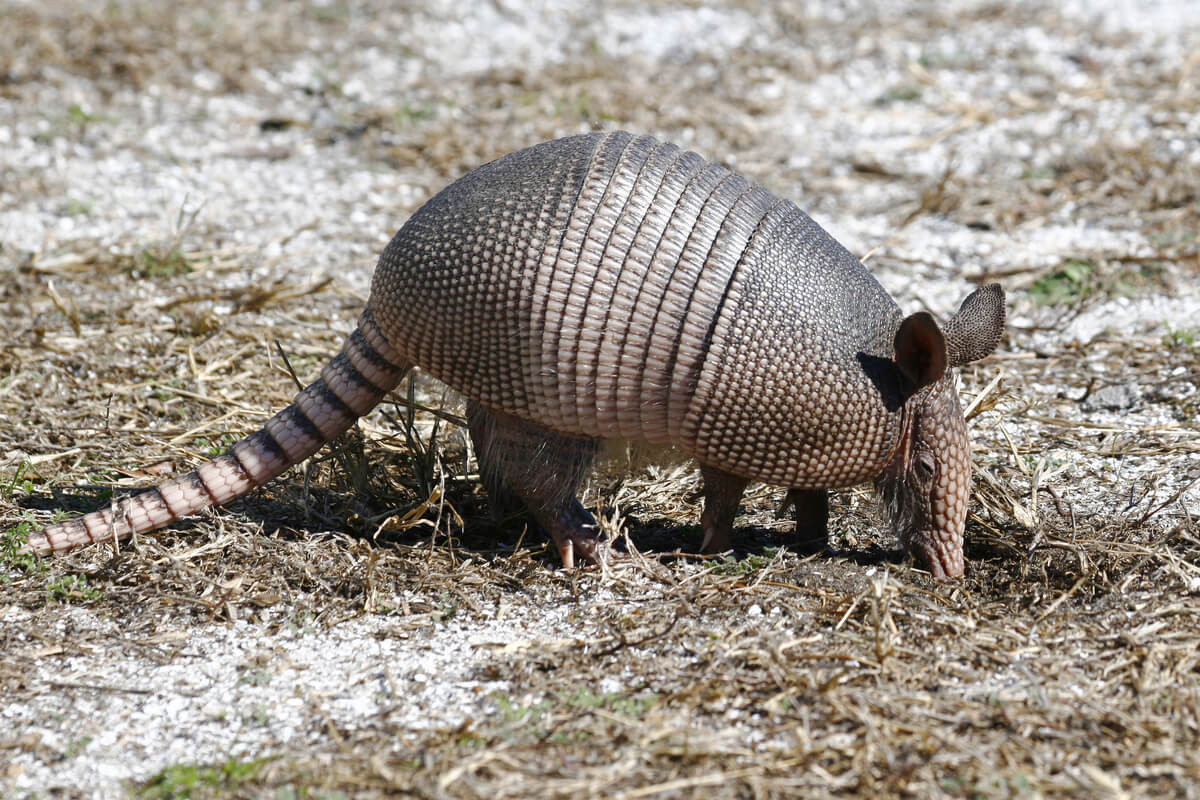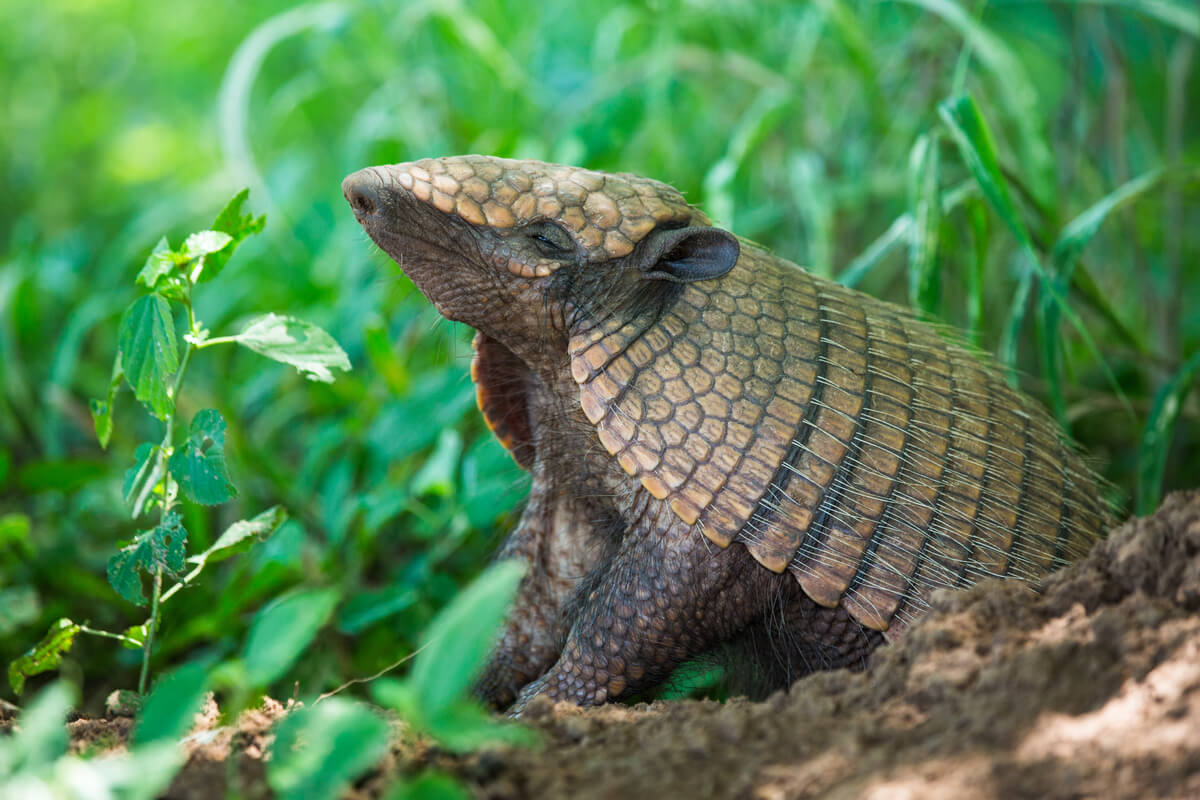10 Curiosities About Armadillos

To date, experts estimate that there are about 6,495 species of mammals on the planet, 95 of them extinct. This group is very well studied due to its genetic closeness to humans, but there are certain mammals whose life cycle and form of survival go unnoticed due to their rarity. Would you like to find out 10 curiosities about armadillos?
Although the image of a grayish animal with a pig’s tail, breastplate, and long nose comes to all of us when we think of an armadillo, you’ll see that there are much more bizarre members of this group. Stay with us and learn some interesting facts about this mammalian taxon, as it undoubtedly includes some of the most fascinating species you can imagine.
1. Armadillos aren’t just one species
Before exploring the lifestyle of armadillos and describing them, it would be good to contextualize them from a phylogenetic point of view. First of all, we need to emphasize that modern armadillos belong to the Dasypodidae family and are included in a single genus with 9 species. The most famous example is Dasypus novemcinctus.
Things get a bit complicated from here on, as the Chlamyphoridae family also includes many species known as “armadillos”. In addition, the diversity of this taxon is much wider, as it’s divided into 3 different subfamilies and 8 genera, with a total of 14 species. Some of its representatives are physically very rare and don’t match the stereotypical concept of the armadillo.
The specimens of both families are related at a genetic level. In total, there are about 21 species of armadillos in the world.
2. A very diverse body plan
Armadillos of the genus Dasypus are easy to describe, as they all have a series of common, striking characteristics that are exclusive to their order. In the first place, it should be noted that they sport armor that covers their sides, back, tail, and upper part of the head, which gives them the appearance of wearing a “shell”.
However, there’s considerable diversity when we talk about measurements and weights. The species Priodontes maximus or giant armadillo reaches 50 kilos and 1 meter (3,3 feet) in length, while its little relative Chlamyphorus truncatus hardly ever weighs less than 90 grams (less than 4 oz) and measures 15 centimeters (6 inches) at most.

3. The shell matters
The arrangement of the shell is very important when it comes to differentiating between species of armadillos. For example, those of the Dasypus genus are characterized by having 6 to 9 mobile bands composed of keratinized skin, which form the dermal shields in charge of protecting their entire body.
Species further from the typical armadillo such as Calyptophractus retusus break stereotypes, as their protective layer is only found in the dorsal area, leaving the flanks and belly exposed, with a pink color similar to that of a mole-rat. In addition, the plates are fused into the pelvis and spine, which gives them a much more fragile and flexible appearance.
The curiosities regarding armadillo armor are so many that they need a whole article of their own.
4. An adaptation to inclement environments
Speaking of armor (regardless of what type), w need to emphasize that this trait is shared by all armadillos to a greater or lesser extent. Experts have postulated that it serves as a method to avoid the attacks of predators, as these mammals don’t have other abilities such as extreme speed or fangs to face their attacks.
However, the armor could also be an evolutionary mechanism to protect these mammals from their own lifestyle. As they’re animals that spend the day browsing on the ground, their armor insulates them from the abrasive soil in times of extreme heat and prevents certain insects from biting or parasitizing them.
5. Few species, but distributed throughout many ecosystems
Although it’s very difficult for most of us to see an armadillo in its natural ecosystem, these mammals have adapted to several different types of environments. They can be found in deserts, mountains, wetlands, and coastal sandy areas. The only species found in the wild in the United States is Dasypus novemcinctus.
The basal lineage of these mammals originated in South America, and due to the isolation of this continent, the armadillos remained isolated from the rest of the planet until the Cenozoic. For this reason, all the species described today are found on the American continent. Paraguay is the country that harbors the most, boasting 11 of them.
6. Armadillos are adapted to the soil
One of the curiosities about armadillos is that most of the species are burrowers. As can be guessed from the physiology of their forelimbs, these mammals need to burrow into the ground to find food, make resting places, and take refuge. Because of this, they have very powerful, thick nails.
Despite their relationship with the terrestrial environment, most armadillos are good swimmers. Some species are even capable of walking on the bottom of the water for short periods of time.
Armadillos aren’t good climbers, as the weight of their armor doesn’t allow them to jump or perform acrobatic movements. Its armor constitutes up to 15% of his total weight.
7. Curiosities about armadillos: a limited diet
Armadillos have a very poor sense of sight, so they must be guided by their smell when looking for food sources. The bulk of their diet consists of invertebrate larvae, adult insects, termites, and non-winged hymenopterans, such as ants.
It’s very interesting to note that some of these species are specialized in hunting only ants, as this dietary strategy greatly limits their ability to survive. To reach them, they use their claws and excavate a corridor measuring the diameter of their body. In this way, they can insert their snouts and feed without a problem on the worker ants, queens and larvae of the anthill.
8. Armadillos have a low body temperature.
The average body temperature of a human being is 37° C. Oddly enough, armadillos have a lower temperature, around 33 to 36° C. They also have very low metabolic rates, 40 to 60% of what’s expected for a mammal of their size and complexity.
This low metabolic rate is especially prominent in species that feed only on termites. However, their “slow way” of living also has benefits, as, despite their small size, they’re considered quite long-lived (some armadillos live more than 15 years).
9. Curiosities about armadillos: unusual reproduction
Undoubtedly, one of the most striking curiosities of the armadillo is its reproduction. Most species of the genus Dasypus give birth to 4 monozygotic twins in each reproductive event, that is, they’re from exactly the same egg. Only one egg is fertilized and implanted, but it splits into 4 identical segments to give rise to more than one individual.
It’s postulated that this is simply because of a lack of space in the female reproductive system. As there’s only “room” in the uterus for the implantation of an egg, its body uses an atypical method to produce more offspring with less effort. Gestation lasts from 60 to 120 days, but it depends a lot on the species.

10. Human research
Armadillos are essential in helping us to understand the dynamics of certain diseases, such as leprosy. They’re one of the few animals that can contract this disease systematically, but the armadillo’s low body temperature makes its body the ideal place for the proliferation of Mycobacterium leprae. Therefore, they’re considered reservoirs of this pathogen.
Its atypical form of reproduction is also of great interest in the scientific community, as there are few examples of living beings that give birth to multiple young in all cases. Undoubtedly, these curiosities about armadillos aren’t only interesting at an informative level, but they can open doors and provide solutions to scientific problems that are difficult to solve.
All cited sources were thoroughly reviewed by our team to ensure their quality, reliability, currency, and validity. The bibliography of this article was considered reliable and of academic or scientific accuracy.
- Dasypodidae, Armadillos. Animal Diversity Web. Recogido a 5 de septiembre en https://animaldiversity.org/accounts/Dasypodidae/
- The nine-banded armadillo, The National Wildlife federation. Recogido a 6 de agosto en https://www.nwf.org/Educational-Resources/Wildlife-Guide/Mammals/Nine-Banded-Armadillo
- McBee, K., & Baker, R. J. (1982). Dasypus novemcinctus. Mammalian species, (162), 1-9.
- Naiff, R. D., Ferreira, L. C., Barrett, T. V., Naiff, M. F., & Arias, J. R. (1986). Paracoccidioidomicose enzoótica em tatus (Dasypus novemcinctus) no estado do Pará. Revista do Instituto de Medicina Tropical de São Paulo, 28(1), 19-27.
